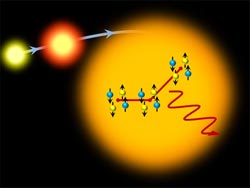Researchers Reveal Structure of Carbon’s ‘Hoyle State’

Alpha clusters in the Carbon-12 nucleus forming a "bent arm" shape.<br>
Carbon-12 can only exist when three alpha particles, or helium-4 nuclei, combine in a very specific way. This combination is known as the Hoyle state. NC State physicist Dean Lee and German colleagues Evgeny Epelbaum, Hermann Krebs and Ulf-G.
Meissner had previously confirmed the existence of the Hoyle state using a numerical lattice that allowed the researchers to simulate how the protons and neutrons interact. When the researchers ran their simulations on the lattice, the Hoyle state appeared together with other observed states of carbon-12, proving the theory correct from first principles.
But they also wanted to find out how the nucleons (the protons and neutrons inside the nucleus of an atom) were arranged inside the nucleus of carbon-12. This would enable them to “see” the structure of the Hoyle state. Using the same lattice, the researchers, along with collaborator Timo Laehde, found that carbon-12’s six protons and six neutrons formed three “alpha clusters” of four nucleons each. At low energy, the alpha clusters tended to clump together in a compact triangular formation. But for the Hoyle state, which is an excited energy state, the three alpha clusters combined in a “bent arm” formation.
The researchers’ findings will appear this month in Physical Review Letters.
“It’s interesting that a straight chain seems not to be the preferred configuration for the Hoyle state,” Lee says. “A bend in the chain seems necessary. This work leads us to the question of what other nuclei have such alpha cluster shapes. These would be rather exotic structures in nuclear physics and open some really interesting questions regarding shape and stability. For example, can we have longer chains of alpha clusters? We are investigating these possibilities.”
The work was funded by the U.S. Department of Energy; the Deutsche Forschungsgemeinschaft, Helmholtz-Gemeinschaft Deutscher Forschungszentren, and Bundesministerium fuer Bildung und Forschung in Germany; European Union HadronPhysics3 Project and the European Research Council; and the National Natural Science Foundation of China. Computational resources were provided by the Juelich Supercomputing Center. The NC State Department of Physics is part of the College of Physical and Mathematical Sciences.
-peake-
Note to editors: an abstract of the paper follows.
“Structure and Rotations of the Hoyle State”
Authors: Dean Lee, North Carolina State University; Evgeny Epelbaum and Hermann Krebs, Institut fuer Theoretische Physik II, Ruhr-Universitaet Bochum, Germany; Timo A. Laehde, Forschungszentrum Juelich, Germany; Ulf-G. Meissner, Helmholtz-Institut fuer Strahlen-und Kernphysik and Bethe Center for Theoretical Physics, Universitaet Bonn, Germany
Published: Physical Review Letters
Abstract:
The excited state of the 12C nucleus known as the “Hoyle state” constitutes one of the most interesting, difficult and timely challenges in nuclear physics, as it plays a key role in the production of carbon via fusion of three alpha particles in red giant stars. In this letter, we present ab initio lattice calculations which unravel the structure of the Hoyle state, along with evidence for a low-lying spin-2 rotational excitation. For the 12C ground state and the first excited spin-2 state, we find a compact triangular configuration of alpha clusters. For the Hoyle state and the second excited spin-2 state, we find a “bent-arm” or obtuse triangular configuration of alpha clusters. We also calculate the electromagnetic transition rates between the low-lying states of 12C.
Media Contact
More Information:
http://www.ncsu.eduAll latest news from the category: Physics and Astronomy
This area deals with the fundamental laws and building blocks of nature and how they interact, the properties and the behavior of matter, and research into space and time and their structures.
innovations-report provides in-depth reports and articles on subjects such as astrophysics, laser technologies, nuclear, quantum, particle and solid-state physics, nanotechnologies, planetary research and findings (Mars, Venus) and developments related to the Hubble Telescope.
Newest articles

Silicon Carbide Innovation Alliance to drive industrial-scale semiconductor work
Known for its ability to withstand extreme environments and high voltages, silicon carbide (SiC) is a semiconducting material made up of silicon and carbon atoms arranged into crystals that is…

New SPECT/CT technique shows impressive biomarker identification
…offers increased access for prostate cancer patients. A novel SPECT/CT acquisition method can accurately detect radiopharmaceutical biodistribution in a convenient manner for prostate cancer patients, opening the door for more…

How 3D printers can give robots a soft touch
Soft skin coverings and touch sensors have emerged as a promising feature for robots that are both safer and more intuitive for human interaction, but they are expensive and difficult…





















